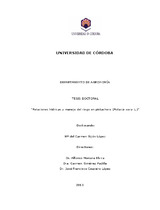Relaciones hídricas y manejo de riego en pistachero (Pistacia vera L.)
Autor
Gijón López, María del Carmen
Director/es
Moriana Elvira, AlfonsoGiménez Padilla, Carmen
Couceiro López, José Francisco
Editor
Universidad de Córdoba, Servicio de PublicacionesFecha
2013Materia
Pistachero (Pistacia vera L.)Cultivo
Riego
Pistachos
Producción
Calidad
METS:
Mostrar el registro METSPREMIS:
Mostrar el registro PREMISMetadatos
Mostrar el registro completo del ítemResumen
El cultivo del pistachero se ha convertido en una alternativa a los
cultivos tradicionales con un creciente interés en zonas concretas de
España, especialmente en Castilla la Mancha. El pistachero es un frutal
tolerante a la sequía, cultivado tanto en condiciones de secano como de
regadío. Puesto que el agua es un recurso cada vez más escaso, en esta
tesis se ha estudiado con diferentes enfoques el comportamiento de este
cultivo ante condiciones de riego y de estrés hídrico. En el primer capítulo
se presenta la respuesta de la producción a diferentes situaciones de
disponibilidad de agua, las cuales se consiguieron aplicando distintos
tratamientos hídricos (riego cubriendo el 100% de las necesidades del
árbol (Control), riego deficitario controlado (RDC), riego deficitario
progresivo con distintas dosis de riego y secano). Los resultados muestran
que el riego incrementa la producción y la calidad de los frutos y que no
existen diferencias en estos parámetros entre el tratamiento RDC y el
control, lo cual apunta a que el riego deficitario controlado (que en este
caso ha supuesto un ahorro de agua de aproximadamente un 20%) es una
buena práctica para este cultivo. En el segundo capítulo se ha estudiado la
respuesta fisiológica de plantas en maceta del cultivar Kerman injertado
sobre 3 portainjertos distintos (Pistacia terebinthus L., P. atlantica Desf. y
un híbrido resultante del cruce de P. atlantica Desf. x P. vera L.) a
condiciones de estrés hídrico y posterior recuperación de las mismas. Los
resultados de este ensayo permitirán elegir el patrón adecuado
dependiendo de las condiciones hídricas que se esperen en la plantación.
Los datos obtenidos indican que en condiciones de una alta dotación de
riego, el híbrido mostraría el mejor comportamiento en cuanto a los
parámetros estudiados, y bajo condiciones de secano la mejor respuesta al
estrés hídrico la mostraría el cultivar injertado sobre el patrón P.
terebinthus. En el tercer capítulo se ha caracterizado la respuesta del
potencial hídrico, la fotosíntesis y el intercambio gaseoso al estrés hídrico
tanto durante ciclos diarios así como durante las 3 fases fenológicas del
desarrollo del fruto. Además se han realizado curvas presión-volumen para
analizar la respuesta al estrés hídrico en cada una de las fases fenológicas.
Se ha observado que las relaciones hídricas en los árboles varían a lo largo... Pistachio has become an alternative to more traditional tree crops
in some areas of Spain, particularly in the Region of Castilla la Mancha.
Pistachio is a drought-resistant fruit tree that can be cultivated under
rainfed and irrigated conditions. Water can be a scarce resource; this
thesis therefore investigates the behavior of this crop under irrigated and
water stress conditions. The first chapter deals with how production
responds to different water availability: irrigation covering 100% of the
needs of the tree (control), regulated deficit irrigation (RDI), sustained
deficit irrigation with different irrigation rates, and rainfed conditions.
Irrigation was associated with an increased yield and better fruit quality,
but no differences were seen in these respects between the RDI and
control treatments. This suggests that RDI, which is associated with a
water saving of approximately 20%, is a good management option for this
crop. The second chapter deals with the physiological responses of potted
pistachio plants (cv. Kerman) on three different rootstocks (Pistacia
terebinthus L, P. atlantica Desf., and the hybrid P. atlantica Desf. x P. vera
L.) to water stress and subsequent rehydration. The results suggest which
rootstock might provide the best results in an orchard depending on water
availability. The hybrid rootstock would appear to be the most adequate
under conditions of good water availability, while the challenge of
increased water stress under rainfed conditions appears to be best met by
the P. terebinthus rootstock. The third chapter characterises the response
to water stress with respect to water potential, photosynthesis and
gaseous exchange, both in terms of daily cycles and during the three
phenological stages of fruit development. Pressure-volume curves were
produced for each phenological stage. It would appear that water relations
in pistachio trees change over the growing season as different
physiological processes are brought into play to achieve drought
adaptation. Progressive stomatal closure starting before noon was
observed as water stress increased. Under moderate water stress
conditions, transpiration efficiency was maximised due to the maintenance
of the photosynthetic rate. Greater osmotic adjustment was seen during...

